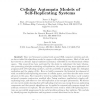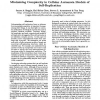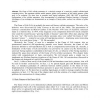50 search results - page 8 / 10 » Intrinsically Universal Cellular Automata |
AC
1998
Springer
13 years 5 months ago
1998
Springer
Abstract: Since von Neumann's seminal work around 1950, computer scientists and others have studied the algorithms needed to support self-replicating systems. Much of this wor...
ISMB
1993
13 years 7 months ago
1993
Understanding self-replication from an information processing perspective is important because, amongother things, it can shed light on molecular mechanismsof biological reproduct...
ALIFE
2010
13 years 6 months ago
2010
Edgar Codd's 1968 design for a self-replicating cellular automata machine has never been implemented. Partly this is due to its enormous size but we have also identified four...
ISVD
2007
IEEE
14 years 9 days ago
2007
IEEE
The spatial cosmic matter distribution on scales of a few up to more than a hundred Megaparsec1 displays a salient and pervasive foamlike pattern. Voronoi tessellations are a vers...
CORR
2004
Springer
13 years 5 months ago
2004
Springer
: The Game of Life cellular automaton is a classical example of a massively parallel collision-based computing device. The automaton exhibits mobile patterns, gliders, and generato...



